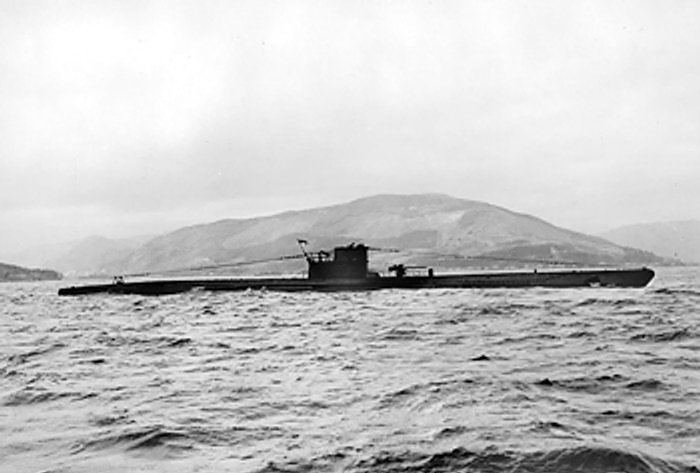Name U-921 Yard number 508 Commissioned 30 May 1943 Launched 3 April 1943 Draft 4.74 m | Ordered 6 June 1941 Laid down 15 October 1941 Construction started 15 October 1941 Length 67 m Beam 6.2 m | |
 | ||
Fate Missing since 24 September 1944 Part of 8th U-boat Flotilla, 13th U-boat Flotilla | ||
German submarine U-921 was a Type VIIC U-boat of Nazi Germany's Kriegsmarine during World War II.
Contents
She was ordered on 6 June 1941, and was laid down on 1 April 1943 at Neptun Werft AG, Rostock, as yard number 508. She was launched on 3 April 1943 and commissioned under the command of Oberleutnant zur See Wolfgang Leu on 30 May 1943.
Design
German Type VIIC submarines were preceded by the shorter Type VIIB submarines. U-921 had a displacement of 769 tonnes (757 long tons) when at the surface and 871 tonnes (857 long tons) while submerged. She had a total length of 67.10 m (220 ft 2 in), a pressure hull length of 50.50 m (165 ft 8 in), a beam of 6.20 m (20 ft 4 in), a height of 9.60 m (31 ft 6 in), and a draught of 4.74 m (15 ft 7 in). The submarine was powered by two Germaniawerft F46 four-stroke, six-cylinder supercharged diesel engines producing a total of 2,800 to 3,200 metric horsepower (2,060 to 2,350 kW; 2,760 to 3,160 shp) for use while surfaced, two SSW GU 343/38-8 double-acting electric motors producing a total of 750 metric horsepower (550 kW; 740 shp) for use while submerged. She had two shafts and two 1.23 m (4 ft) propellers. The boat was capable of operating at depths of up to 230 metres (750 ft).
The submarine had a maximum surface speed of 17.7 knots (32.8 km/h; 20.4 mph) and a maximum submerged speed of 7.6 knots (14.1 km/h; 8.7 mph). When submerged, the boat could operate for 80 nautical miles (150 km; 92 mi) at 4 knots (7.4 km/h; 4.6 mph); when surfaced, she could travel 8,500 nautical miles (15,700 km; 9,800 mi) at 10 knots (19 km/h; 12 mph). U-921 was fitted with five 53.3 cm (21 in) torpedo tubes (four fitted at the bow and one at the stern), fourteen torpedoes or 26 TMA mines, one 8.8 cm (3.46 in) SK C/35 naval gun, 220 rounds, and an anti-aircraft gun. The boat had a complement of between 44 — 52 men.
Service history
On 24 May 1944, only seven days after being commissioned, U-921 was spotted off Norway, enroute to Narvik, by a Canadian Sunderland, DV990, of 422/R Squadron RCAF piloted by F/O G.E. Holley. U-921 had been searching for U-476 which had been attack from the air earlier in the day and badly damaged. U-921 was able to hit the Sunderland on its attack run causing it to crash into the sea after dropping three depth charges, which resaulted in no damage to U-921 but all the crewmen of the Sunderland were lost.
Shortly after this first attack U-921 was sighted by another Canadian Sunderland, DW111, of 423/S Squadron RCAF piloted by F/L R.H. Nesbitt. U-921 was able to avoid the five depth charges dropped by the Sunderland but strafing wounded the commander, Oblt.z.S. Wolfgang Leu, and two other crewmen. As U-921 was diving, Leu was able to get both of the wounded crewmen below, but then closed to hatch to prevent her from sinking, sacrificing himself. U-921 sailed for Trondheim, arriving 26 May 1944, under command of her I. WO (1st Wachoffizier) Korvettenkapitän Heinz-Joachim Neumann.
On 24 September 1944, 20 days into her second war patrol, U-921 sent her last radio transmission from 74°45′N 13°50′E, west of Bear Island in the Norwegian Sea, in which she stated that, due to unspecified damage, she needed to return to port. U-921 was ordered to continue to operate against Convoy RA 60 and postpone her return. On 2 October 1944 she was listed as missing when, after the end of the convoy battle, she failed to return to Narvik.
Wolfpacks
U-921 took part in one wolfpack, namely.
